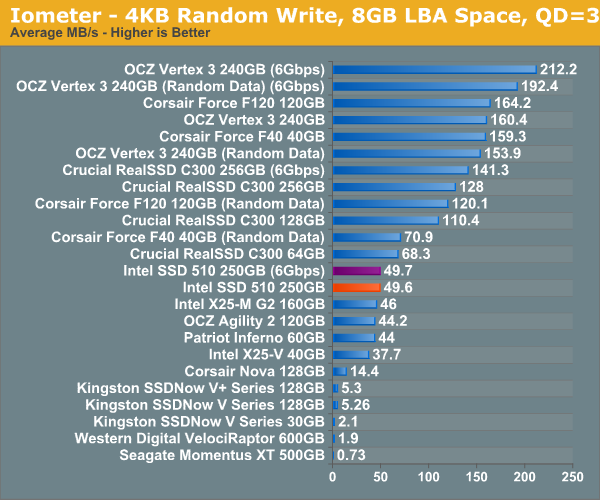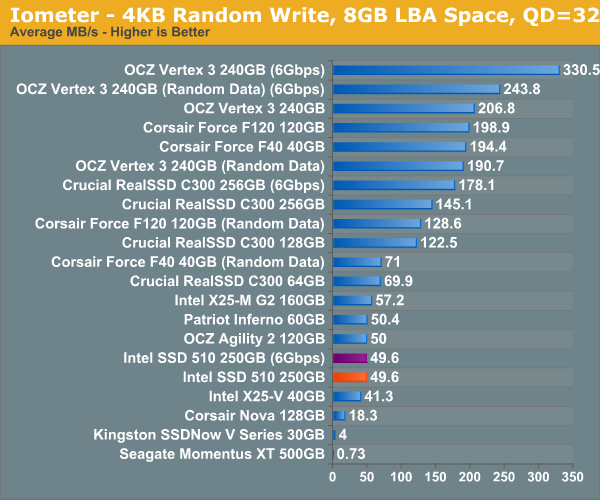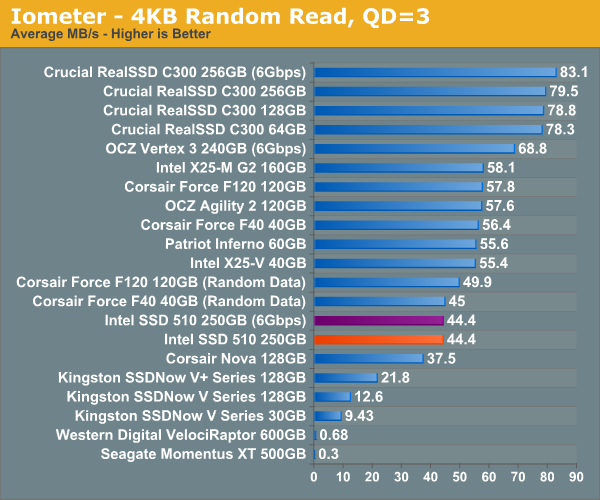The Intel SSD 510 Review
by Anand Lal Shimpi on March 2, 2011 1:23 AM EST- Posted in
- IT Computing
- Storage
- SSDs
- Intel
- Intel SSD 510
Random Read/Write Speed
The four corners of SSD performance are as follows: random read, random write, sequential read and sequential write speed. Random accesses are generally small in size, while sequential accesses tend to be larger and thus we have the four Iometer tests we use in all of our reviews.
Our first test writes 4KB in a completely random pattern over an 8GB space of the drive to simulate the sort of random access that you'd see on an OS drive (even this is more stressful than a normal desktop user would see). I perform three concurrent IOs and run the test for 3 minutes. The results reported are in average MB/s over the entire time. We use both standard pseudo randomly generated data for each write as well as fully random data to show you both the maximum and minimum performance offered by SandForce based drives in these tests. The average performance of SF drives will likely be somewhere in between the two values for each drive you see in the graphs. For an understanding of why this matters, read our original SandForce article.

It's a bit unfortunate for Intel that we happen to start our performance analysis with a 4KB random write test in Iometer. The 510's random write performance is only marginally better than the X25-M G2 at 49.7MB/s. The RealSSD C300 is faster, not to mention the SF-1200 based Corsair Force F120 and the SF-2200 based OCZ Vertex 3.
Although not depicted here, max write latency is significantly reduced compared to the X25-M G2. While the G2 would occasionally hit a ~900ms write operation, the 510 keeps the worst case latency to below 400ms. The Vertex 3 by comparison has a max write latency of anywhere from 60ms - 350ms depending on the type of data being written.
Many of you have asked for random write performance at higher queue depths. What I have below is our 4KB random write test performed at a queue depth of 32 instead of 3. While the vast majority of desktop usage models experience queue depths of 0 - 5, higher depths are possible in heavy I/O (and multi-user) workloads:

While the X25-M G2 scaled with queue depth in our random write test, the 510 does not. It looks like 50MB/s is the absolute highest performance we'll see for constrained 4KB random writes. Note that these numbers are for 4KB aligned transfers, performance actually drops down to ~40MB/s if you perform sector aligned transfers (e.g. performance under Windows XP).

Random read performance is just as disappointing. The X25-M G2 took random read performance seriously but the 510 is less than 20% faster than the Indilinx based Corsair Nova. When I said the Intel SSD 510's random performance is decidedly last-generation, I meant it.










128 Comments
View All Comments
lyeoh - Wednesday, March 2, 2011 - link
Oh yeah, thanks for the max latency figures. They're very useful.The G2's max of 900ms is quite a long time. Nearly a second! What are the max latencies for say a velociraptor in similar tests? I know the theoretical figures would be based on seek time + RPM but often theory is different from practice.
I find it interesting that the Crucial RealSSD C300 does worse than the Intel SSD 510 in the "Anand Storage Bench 2011- Heavy Workload" despite getting better numbers in the random and sequential tests. Any idea why this would be so? Poorer max latency?
jimhsu - Wednesday, March 2, 2011 - link
Poorer sequential performance I guess. The C300 (which I just got) is very fast, but the sequential perf of the 510 is simply better, which impacts a lot of the sequential portion of the workload test. Random performance in typical desktop models has reached somewhat of a plateau, particularly since most applications currently out there are optimized for the dog-slow random performance of consumer hard drives.Creepwood - Friday, March 4, 2011 - link
About reliability/compatibility: have you tested this drive in the new Sandy Bridge Macbook Pro? Any issues?davepermen - Monday, March 7, 2011 - link
Interestingly, one of THE main performance cases is when you need to quickly write lots of stuff, like in video editing. And there, all data is at least partially compressed, so i guess there the intel will be in a better place.RaistlinZ - Wednesday, March 2, 2011 - link
Intel is going to have to price this thing cheaper than the Vertex 3, or any other new Sandforce SSD for that matter. They can't use performance as a selling point. I'm sure the new SF controller will offer good stability. Unless you're an Intel fanboy I don't see any reason to get the 510 over the Vertex 3, unless they price it much lower.semo - Wednesday, March 2, 2011 - link
This is an Atom alright!I think the conclusion, although critical in places was overall mild. “It looks like we may have hit the upper limit of what we need from 4KB random write performance”… Yeah, in the consumer/budget space. But what consumer/budget computer user would buy a 250GB SSD. I’ve managed to convince a few of my clients to go with an “expensive upgrade” and in the end they’ve been extremely happy… In those cases I’ve only installed 64GB drives.
At the moment SSDs are NOT mainstream and it’s mostly the enthusiast and pro crowd that will be buying consumer grade SSDs. I’ll be using my SSD for VMs for testing and studying and I do a lot of heavy random IO operations.
For a drive as big and as expensive as the 250GB 510, I expect much better across-the-board performance.
TSnor - Wednesday, March 2, 2011 - link
Hi, the article states "~900ms write operation, the 510 keeps the worst case latency to below 400ms. The Vertex 3 by comparison has a max write latency of anywhere from 60ms - 350ms"microseconds are usually abbreviated us, where the u has a funny tail on it. (the u is greek for something)
ms usually means milliseconds. I usually type 'mics' when on the keyboard and reserve the funny u for when handwriting. example, a good SSD write takes less then 100 mics.
saying something is around 900 ms means it takes about a second.
epicsnackus - Wednesday, March 2, 2011 - link
The article is correct, the numbers are really in milliseconds. The microsecond numbers you're thinking of are 1) best case, and 2) usually readsChloiber - Wednesday, March 2, 2011 - link
"Write speed with fully incompressible data is easily a victory for the SF-2200 based OCZ Vertex 3."I think you meant fully compressible?
Anand Lal Shimpi - Wednesday, March 2, 2011 - link
Fixed! Thank you :)Take care,
Anand